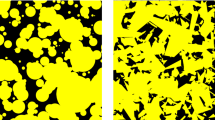Abstract
Although Boolean model simulation has been widely used during the last two decades to simulate sedimentary bodies (especially in fluvio-deltaic environments), a key issue has subsisted. One of the most important parameter for object model simulation, namely the (non stationary) intensity of the underlying object process, is not a parameter provided by the end user but must instead be computed from other input parameters, such as local proportions of lithofacies, erosion rule between objects of different types and interaction between objects. This paper revisits a birth and death algorithm for simulating conditional, non stationary, multi-type objects models with interaction. It provides workable approximations for computing the local intensity of the underlying point process to respect proportion maps. Simulated examples show that this algorithm is able to reproduce the desired proportions. Important issues for implementing this algorithm are discussed.
Similar content being viewed by others
References
Benito García-Morales, M., 2003, Non stationnarité dans les modèles de type Boléen: application à la simulation d'unités sédimentaires: PhD Thesis, Ecole Nationale Supérieure des Mines de Paris, Centre de Géostatistique, 205 p.
Brooks, S., and Roberts, G., 1998, Assessing convergence of Markov Chain Monte-Carlo algorithms: Statistics and Computing, v. 8, p. 319–335.
Carle, S. F., and Fogg, G. E., 1996, Transition probability-based indicator geostatistics: Math. Geol., v. 28, no. 4, p. 453–476.
Gelman, A., and Rubin, D. B., 1992, Inference from iterative simulations using multiple sequences (with discussion): Stat. Sci., v. 7, p. 457–511.
Gelman, A., 1996, Inference and monitoring convergence, in Gilks, W. R., Richardson, S., and Spiegelhalter, D. J., eds., Markov Chain Monte Carlo in practice: Chapman & Hall, London, p. 131–144.
Geyer, C., 1994, On the convergence of Monte Carlo maximum likelihood calculations: J. Royal Stat. Soc., Ser. B, Vol. 56, p. 261–274.
Gilks, W. R., Richardson, S., and Spiegelhalter, D. J., 1996, Markov Chain Monte Carlo in practice: Chapman & Hall, London, 486 p.
Gooverts, P., 1997, Geostatistics for natural resources evaluation: Oxford University Press, Oxford, 483 p.
Haldorsen, H. H., and Macdonald, C. J., 1987, Stochastic modeling of underground reservoir facies (SMURF): Soc. Petrol. Engr. 16751, p. 575–589.
Kelly, F., and Ripley, B. D., 1976, A note on Strauss's model for clustering: Biometrika, v. 63, no. 2, p. 357–360.
Lantuéjoul, C., 1997, Iterative algorithms for conditional simulations, in Baafi, E. Y., and Schofield, N. A., eds, Geostatistics Wollongong '96: Kluwer Academic Publishers, Dordrecht, p. 27–40.
Lantuéjoul, C., 2002, Geostatistical simulation; models and algorithms: Springer-Verlag, Berlin, 256 p.
Le Loc'h, G., and Galli, A., 1997, Truncated plurigaussian method: Theoretical and practical points of view, in Baafi E. Y. and Schofield, N. A., eds, Geostatistics Wollongong '96: Kluwer Academic Publishers, Dordrecht, p. 211–222.
Lia, O., Tjelmeland, H., and Kjellesvik, L., 1997, Modeling of facies architecture by marked point models, in Baafi, E. Y., and Schofield, N. A., eds, Geostatistics Wollongong '96: Kluwer Academic Publishers, Dordrecht, p. 386–397.
Meyn, S. P., and Tweedie, R. L., 1993, Markov chains and stochastic stability: Springer-Verlag, London, 550 p.
Raftery, A. E., and Lewis, S. M., 1992, How many iterations in the Gibbs sampler? in Bernardo, J. M., Bayarri, M. J., Philip, D., A., Berger, J. O., Heckerman, D., Smith, A. F. M., and West, M., eds., Bayesian statistics 4: Oxford University Press, Oxford, p. 763–773.
Robert, C., and Casella, G., 1999, Monte Carlo statistical methods: Springer Verlag, New-York, 507 p.
Stoyan, D., Kendall, W., and Mecke, J., 1995, Stochastic geometry and its applications, 2nd ed.: John Wiley, Chichester, 436 p.
Strauss, D. J., 1975, A model for clustering: Biometrika, v. 62, no. 2, p. 467–475.
Strebelle, S., 2002, Conditional simulation of complex geological structures using multi-points statistics: Math. Geol., v. 34, no. 1, p. 1–22.
Syversveen, A. R., and Omre, H., 1997, Conditioning of marked point processes within a bayesian framework: Scand. J. Stat., v. 24, p. 341–352.
Syversveen, A. R., and Omre, H., 1997, Marked point models for facies units conditioned on well data, in Baafi, E. Y., and Schofield, N. A., eds., Geostatistics Wollongong'96: Kluwer Academic Publishers, Dordrecht, p. 415–423.
van Lieshout, M. N. N., 2000, Markov point processes: Imperial College Press, London, 175 p.
Yu, B., and Mykland, P., 1997, Looking at Markov sampler through cusum path plots: A simple diagnostic idea: Statistic and Computing, v. 8, p. 275–286.
Author information
Authors and Affiliations
Corresponding author
Rights and permissions
About this article
Cite this article
Allard, D., Froidevaux, R. & Biver, P. Conditional Simulation of Multi-Type Non Stationary Markov Object Models Respecting Specified Proportions. Math Geol 38, 959–986 (2006). https://doi.org/10.1007/s11004-006-9057-5
Published:
Issue Date:
DOI: https://doi.org/10.1007/s11004-006-9057-5




